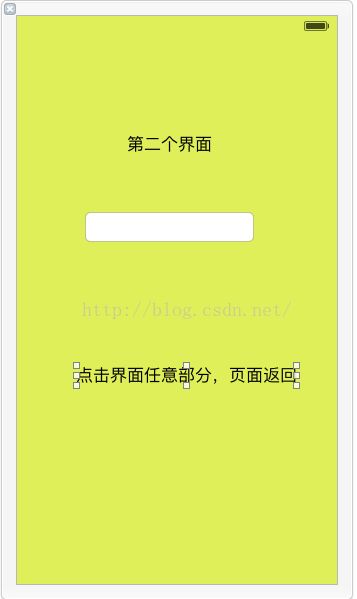IOS学习之——ViewController之间双向传值(反向为代理模式)
下面的代码如下,正向传值是用普通的传值模式,反向传值用的是代理模式。实现代理模式的步骤如下:
代理方:
1.遵守原则 (遵守协议)
2.实现代理方法 (实现协议中的方法)
3.设置委托方的代理人
委托方 :
1.制定原则 (协议)
2.声明代理的属性(协议类型的属性) delegate
3.在适当的时机,让代理人执行代理方法 (delegate调用协议中的方法)
第一个界面的头文件和实现文件如下:
#import <UIKit/UIKit.h> @interface OneViewController : UIViewController @end
//
// OneViewController.m
// 双向传值
//
// Created by spare on 16/4/16.
// Copyright © 2016年 spare. All rights reserved.
//
//代理方:
//1.遵守原则 (遵守协议)
//2.实现代理方法 (实现协议中的方法)
//3.设置委托方的代理人
#import "OneViewController.h"
#import "TwoViewController.h"
//1.遵守原则 (遵守协议)
@interface OneViewController ()<TwoDelegate>@property (weak, nonatomic) IBOutlet UITextField *textField1;
@end
@implementation OneViewController
//2.实现代理方法 (实现协议中的方法)
-(void)sendTwoController:(TwoViewController *)twoController message:(NSString *)message{
//将从页面2返回的值,传到页面1的textField
self.textField1.text=message;
}
//点击屏幕任意位置,进入页面2
-(void)touchesBegan:(NSSet<UITouch *> *)touches withEvent:(UIEvent *)event{
//初始化将要进入的页面
TwoViewController *vc2=[[TwoViewController alloc]init];
//正向传值代码:通过页面2定义的Content属性,将值传给页面2
vc2.content=self.textField1.text;
//3.设置委托方的代理人
//反向传值代码:设置代理(很重要!!!)
vc2.delegate=self;
[self presentViewController:vc2 animated:YES completion:nil];
}
- (void)viewDidLoad {
[super viewDidLoad];
// Do any additional setup after loading the view from its nib.
}
- (void)didReceiveMemoryWarning {
[super didReceiveMemoryWarning];
// Dispose of any resources that can be recreated.
}
/*
#pragma mark - Navigation
// In a storyboard-based application, you will often want to do a little preparation before navigation
- (void)prepareForSegue:(UIStoryboardSegue *)segue sender:(id)sender {
// Get the new view controller using [segue destinationViewController].
// Pass the selected object to the new view controller.
}
*/
@end
第二个界面的头文件和实现文件如下:
// TwoViewController.h // 双向传值 // // Created by spare on 16/4/16. // Copyright © 2016年 spare. All rights reserved. // ////委托方 : //1.制定原则 (协议) //2.声明代理的属性 (协议类型的属性) delegate //3.在适当的时机,让代理人执行代理方法 (delegate 调用协议中的方法) #import <UIKit/UIKit.h> @class TwoViewController; //1.制定原则 (协议) @protocol TwoDelegate <NSObject> -(void)sendTwoController:(TwoViewController*)twoController message:(NSString*)message; @end @interface TwoViewController : UIViewController @property(nonatomic,copy)NSString *content; //2.声明代理的属性 (协议类型的属性) delegate @property(nonatomic,strong)id<TwoDelegate> delegate; @end
//
// TwoViewController.m
// 双向传值
//
// Created by spare on 16/4/16.
// Copyright © 2016年 spare. All rights reserved.
//
#import "TwoViewController.h"
@interface TwoViewController ()
@property (weak, nonatomic) IBOutlet UITextField *textField2;
@end
@implementation TwoViewController
- (void)viewDidLoad {
[super viewDidLoad];
}
-(void)touchesBegan:(NSSet<UITouch *> *)touches withEvent:(UIEvent *)event{
//3.在适当的时机,让代理人执行代理方法 (delegate 调用协议中的方法)
[self.delegate sendTwoController:self message:self.textField2.text];
[self dismissViewControllerAnimated:YES completion:nil];
}
//每次进入页面的时候,都去刷新获得的值
-(void)viewWillAppear:(BOOL)animated{
//通过中间属性,传值给textField2;
self.textField2.text=self.content;
}
- (void)didReceiveMemoryWarning {
[super didReceiveMemoryWarning];
// Dispose of any resources that can be recreated.
}
/*
#pragma mark - Navigation
// In a storyboard-based application, you will often want to do a little preparation before navigation
- (void)prepareForSegue:(UIStoryboardSegue *)segue sender:(id)sender {
// Get the new view controller using [segue destinationViewController].
// Pass the selected object to the new view controller.
}
*/
@end

